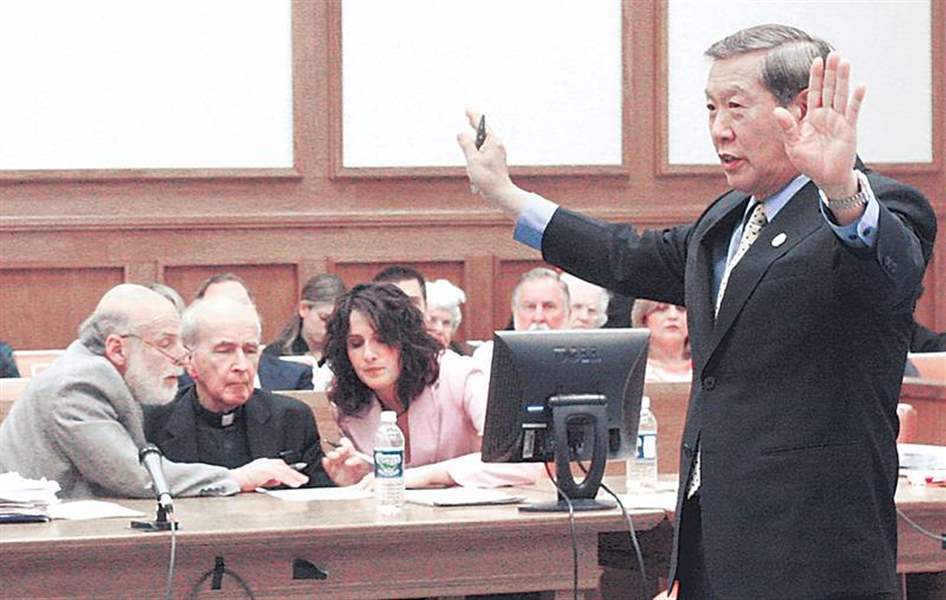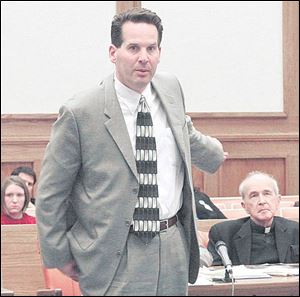
Forensic expert says letter opener could have been used to stab nun
4/28/2006
Henry Lee, a well-known forensic investigator, testifies yesterday.
But while he found consistencies and similarities between the priest's sword-shaped letter opener and the murder weapon, Mr. Lee said he could not conclude that it was the specific letter opener used in the slaying 26 years ago.
Father Robinson, 68, is charged with murder in Lucas County Common Pleas Court in the choking and stabbing death of Sister Margaret Ann at the former Mercy Hospital, now a college.

Defense attorney John Thebes questions Megan Shaffer (not pictured) of ReliaGene Technologies about DNA material found on Sister Margaret Ann Pahl s fingernail clippings.
Also yesterday, a retired Mercy Hospital night nursing supervisor testified that she stopped at the hospital chapel to pray every day after her 11 p.m.-to-7 a.m. shift, except for one day - April 5, 1980, the day of the murder.
"I could not get in. It was locked," Rose Byers said. "It was the first time I could not get in."
Jerry Tressler, a retired ambulance driver, said he saw Sister Margaret Ann about 6:50 that morning, passing her in a dark hallway as he headed toward the hospital's cafeteria for an employee-discount breakfast.
"I said, 'Good morning, sister,' and she nodded her head," Mr. Tressler said.
He is the last person, besides the killer, known to have seen Sister Margaret Ann alive.
Mr. Lee said yesterday that he used chemicals to enhance the visibility of blood on the altar cloth, and he pointed out similarities between bloody imprints on the 10-foot piece of white linen and the size and shape of the letter opener. The letter opener was found in Father Robinson's apartment after he consented to a police search on April 18, 1980.
Mr. Lee, the forensics expert well-known for his "bloody footprints" analysis on behalf of the defense in the O.J. Simpson murder trial, testified for about 40 minutes in Judge Thomas Osowik's court, explaining like a patient professor some of the scientific techniques he used to examine the evidence.
Mr. Lee showed a magnified image of a small circular bloodstain found on the altar cloth and demonstrated how a rectangular and an oval shape within that circle appeared to match the shape of the U.S. Capitol building embossed on a medallion on the letter opener.
That finding echoed a similar analysis by forensics expert Paulette Sutton of Memphis, who testified Wednesday. Mr. Lee and Ms. Sutton are two of only five people in the world certified in the field of blood-pattern transfer analysis.
Flashing an occasional smile, the Taiwan-born Mr. Lee said Gary Cook, a former assistant prosecutor who is now a Lucas County Common Pleas Court judge, and a Toledo police detective first approached him in August, 2004, about consulting in the Father Robinson case.
He joked that he could not tell the court who the detective was because "all the Caucasians look alike."
When asked to review an 8-inch by 10-inch crime-scene photo, Mr. Lee pulled a large magnifying glass out of his briefcase and said he carries it everywhere. "You never know when you might need to investigate a crime scene or examine evidence, and it's impossible to carry a microscope around," he said.
The jury of 16 - 12 jurors and four alternates - paid close attention to Mr. Lee's presentation, leaning forward in their seats as they looked at photos of bloodstains and the letter opener on the courtroom's Smart Board - a large, high-tech screen that combines the features of a projector, a white board, and a computer monitor.
Mr. Lee explained that there are two kinds of bloodstains - static and dynamic, and he pointed out the two different types found on the altar cloth. The static stains are made when a blood-covered object makes quick, solid contact with a surface, while dynamic stains are found when a blood-covered object moves across a surface.
He said he came to Toledo on Dec. 28 and 29, 2004, and reviewed original crime-scene photos, examined the sacristy where Sister Margaret Ann's body was found, and visited the Lucas County medical examiner's office to look at her clothing and other evidence.
He conducted a "limited re-creation" of the crime scene, he said, and concluded that Sister Margaret Ann was quickly made unconscious by her attacker and that the stabbings took place after she was lying on the marble floor.
There were no signs of a struggle - no furniture was overturned, the religious items in the sacristy were not knocked over - and the blood showed no evidence of dripping, meaning that Sister Margaret Ann already was lying down when stabbed, he said.
Police and prosecutors have said in court that the murderer choked the nun with a soft cloth or other ligature to the verge of death, then laid her down on the floor, covered her with an altar cloth, and stabbed her nine times over the heart in the near-perfect shape of an inverted cross. The attacker then removed the altar cloth and stabbed Sister Margaret Ann 22 more times.
Mr. Lee said the killer may have "staged" the victim's body to mislead police into thinking it was a sexual assault by pulling the nun's undergarments down to her ankles and lifting her dress up to her chest.
Earlier yesterday, DNA specialists testified that material found in clippings from the nun's fingernails contained male chromosome that could not have come from Father Robinson.
Diane Gehres of the Ohio Bureau of Criminal Identification and Investigation said she tested swabs taken from the letter opener's medallion in 2000 - about four years before Father Robinson's April 23, 2004, arrest - but found no DNA samples. Police previously testified that the letter opener was suspiciously clean - devoid of fingerprints, dust, or other residue.
Megan Shaffer, assistant director of ReliaGene Technologies, a private DNA laboratory in New Orleans, said she cut in half fingernail clippings from each of Sister Margaret Ann's 10 fingers and tested them as a group for DNA. Those tests showed the presence of a male chromosome that did not match Father Robinson's DNA.
John Thebes, one of the priest's four defense attorneys, asked if Sister Margaret Ann could have gotten the DNA material on her nails while fighting off an attacker, and Ms. Shaffer said that was possible.
Prosecutors challenged the DNA results by questioning whether the male chromosome could have come from someone who sneezed or breathed on the fingernails anytime over the last 26 years, and Ms. Shaffer said that also was possible.
Retired Toledo police Detective Ed Marok, of the scientific investigation unit, said he believes either he or former deputy coroner Dr. Renate Fazekas clipped the nun's nails, and that he could not remember if scissors or clippers were used.
Questioned by Lucas County Assistant Prosecutor Chris Anderson, Detective Marok said he did not clean his clipping gear between procedures.
Father Robinson's murder trial, believed to be the first of a U.S. Roman Catholic priest charged in the slaying of a Roman Catholic nun, began April 21 and is expected to last three to four weeks. The priest, who wears his clerical collar in court, maintains his innocence.
Contact David Yonke at:
dyonke@theblade.com
or 419-724-6154.